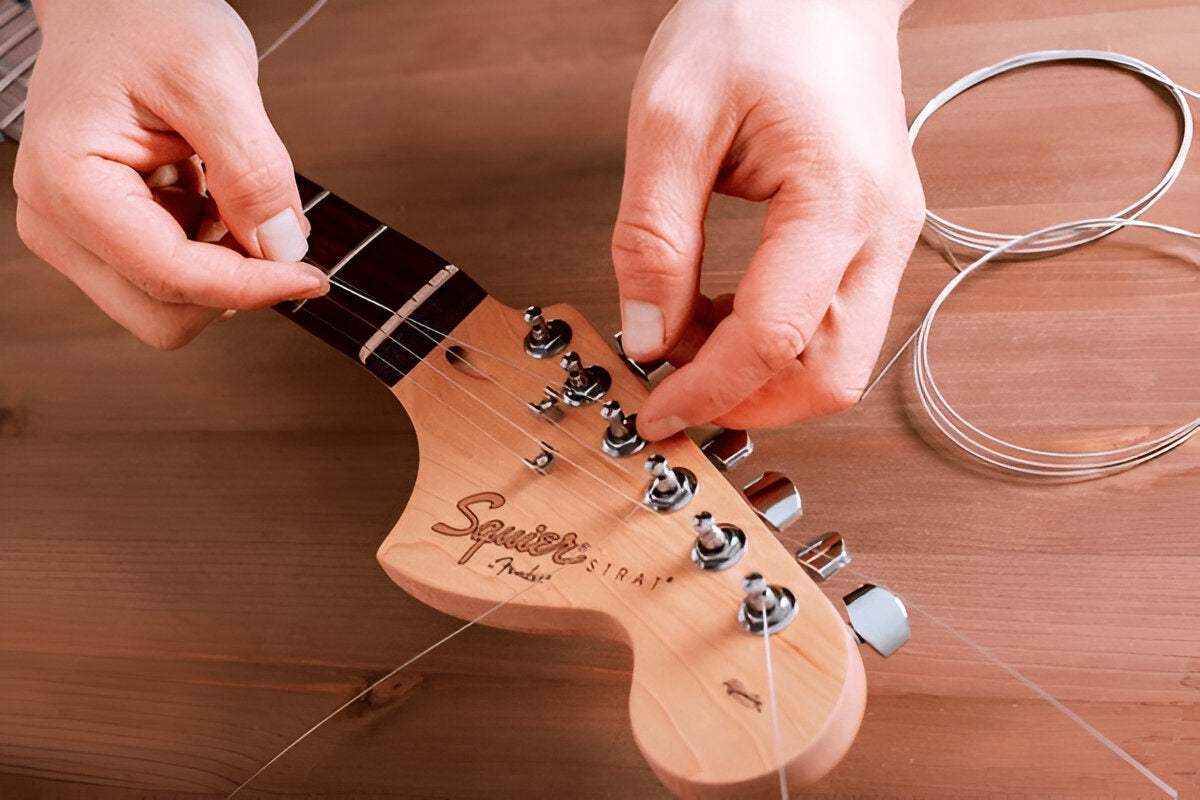Chords are undeniably the building blocks of music, but scales are the cement that holds everything together. Scales allow you to create melodies, as well as add harmonies to them. They are also the core element in the construction of solos and improvising, making them an invaluable part of the musical vocabulary of any guitarist.
The scale that governs all other scales is the major scale. It is the fundamental musical skeleton around which all other scales (as well as chords, modes, etc.) are formed. But before we find out why it’s the most important scale to learn on guitar, let’s get started with the basics…
What is a Major Scale?
Most of you will probably be too young to remember a cheesy movie from the mid-60s called The Sound of Music. However, you will probably know the most famous song from it, the again, rather cheesy, Do Re Mi. As a reminder, here are the truly inspiring lyrics:
DO - a deer, a female deer
RE - a drop of golden sun
MI - a name, I call myself
FA - a long long way to run
SO - a needle pulling thread
LA - a note to follow SO
TI - a drink with jam and bread
That will bring us back to DO
…I thought that would jog your memories. This song was taught to schoolchildren in music lessons worldwide for decade upon decade to reinforce - Do - Re - Mi - Fa - So - La - Ti - Do. But what does this strange combination of letters mean? Well, it’s a major scale. So, every time you sing Do - Re- Mi - etc., you are in fact singing a major scale.
Sorry, but it’s time for a little bit of boring music theory…
The major scale contains seven notes - Do - Re - Mi - Fa - So - La - Ti - before bringing us back to - Do - the start note of the scale. These are called degrees of the scale, for example, Re is the second degree of the scale, and So is the fifth degree of the scale. Therefore we get:
Do - Re - Mi - Fa - So - La - Ti - Do
1st - 2nd - 3rd - 4th - 5th - 6th - 7th - 8th/1st
The final Do can be thought of as the 8th degree of the scale, or the 1st an octave higher.
Degrees are used when creating chord formulas, other scales, and just about every other theoretical instance of music. Keeping things simple, the C major scale does not contain any sharps or flats, therefore the notes are:
Do - Re - Mi - Fa - So - La - Ti - Do
1st - 2nd - 3rd - 4th - 5th - 6th - 7th - 8th/1st
C - D - E - F - G - A - B - C
The chord formula for a major chord is 1 - 3 - 5, therefore it contains the first, third, and fifth degrees of the major scale. Since we know the C major scale contains the notes listed above, we therefore know that a C major chord contains the notes C, E, and G.
A minor seventh chord has the chord formula of 1 - b3 - 5 - b7, therefore it contains the first (root), the flattened third (minor third), the fifth (perfect fifth), and the flattened seventh (minor seventh) degrees of the major scale. Therefore we can deduct using the notes listed above that a Cminor7th chord (Cm7) contains the notes C, Eb, G, and Bb.
The major scale is the only scale that can be used for this type of theoretical deduction. Scales such as the pentatonic are fantastic for learning to improvise and have a sound all of their own, but they can not be used to establish chords or other scales. That’s what makes the Major undeniably, the King of Scales.
So, what’s the difference between a Major Scale, a Major Pentatonic Scale, and a Major Blues Scale?
As I covered in my in-depth look at the pentatonic scale, it contains the 1st, 2nd, 3rd, 5th, and 6th degrees of the major scale. Therefore, if you remove the 4th degree as well as the 7th degree from a major scale, you are left with a five-note scale - the major pentatonic.
As for the Major Blues scale, it contains the 1st, 2nd, flattened 3rd, 3rd, 5th, and 6th degrees of the major scale. It is the same as a pentatonic scale but with the addition of a flattened 3rd. Or, as you should think of it, it is the major scale with a flattened third added and the 4th and 7th degrees removed.
I know that this must be quite complicated for any beginners out there, but you don’t need to understand all this theory yet, just be aware of it. Over time and exposure to these theoretical concepts, everything will start to fall into place.
What scales do most famous guitarists use?
I’ve been going on and on about how fundamental and important the major scale is to music, so you must be thinking that it’s the only scale you ever need to learn to become the next guitar god.
Well… the truth is that most famous guitarists use the minor and major pentatonic scales, or even the blues scale, far more than they use the major scale. This is mainly because the pentatonic is usually the first scale they learn, it is by far the easiest to play, and it works so well over any chord progression you play it over.
However, this isn’t strictly true either. Even though everyone from Jimi Hendrix to Jimmy Page to Slash to John Mayer predominantly play pentatonic scales, they will often add notes from the major scale to the mix. There are many reasons for this, such as when they need a certain tone to match a chord they are playing over, or they want to create a different feel/vibe from the simplistic sound that the pentatonic scale produces.
But if we take a look at more complex forms of guitar music such as jazz, then major scales, as well as scales and modes created from them are key. The sound of a pentatonic is too basic for jazz aficionados, they want more, so the major scale and its cousin the minor scale (and its variations) come into play a lot more than they do in rock and pop music.
How to Play the Major Scale
If you’re a complete beginner then I suggest you start by learning the root positions of the major scales in some of the most common keys, such as C, G, etc. These are incredibly useful for creating simple licks and fills that you can use when playing basic songs using root chords.
The following diagram shows a C major scale in its root position. Start by playing a root C chord, then play the scale starting with your third finger on the C note on the third fret of the A string (shown with a thick black line). Move through every note until you get to the C note on the first fret of the B string. Then go back down through the scale, returning to the C note that you started on.

Once you have learned the scale, play a simple song, using, for example, the chords C, D, Am, and G, and try using the notes of the scale to play two or three-note fills in between each chord. These can be runs, hammer-ons, pull-offs, or whatever you feel like playing. Be creative and you’ll soon take a rather simplistic chord sequence and make it sound a lot more interesting. You can also include the other notes of the C major scale on the B string and the high e string once you get the hang of it.
As mentioned you can do this for any other key as well, so learn your root G major scale and try playing it over a song such as Knocking on Heavens Door, or anything else in the key of G major or E minor.
Let’s now move on to the moveable major-scale shapes. Most guitarists start with the G major scale which is played from the G note on the third fret of the low E string. Once again, play the scale from the root note up to the highest note before returning to the root, as shown in the diagram below:

This can be expanded to include all five positions (or seven if you extend them) of the G Major Scale, as shown below. As is the case when learning any scale, start and finish each position on the root note.

You’ll need to memorize these patterns through focused practice to unlock the power of the major scale. But don’t just practice them in isolation, run through them a few times slowly to make sure that you are playing them perfectly, then put a great song or a backing track on and play them over that. Plus, remember to practice them in every key, not just in G major.
While on the subject of practicing, are you aware of…
Fragment Patterns
Learning scales is often laborious and boring, so there must be a better, more fun way to do it. Well yes, there is - fragment patterns.
You can split a scale up mathematically using different patterns, these are called Fragment Patterns. They produce more interesting fingerings and also make the scale sound much more musical and relevant to real-world playing when you are practicing it.
I gave a full explanation of how to play them in my article on Pentatonic Scale Guitar - Everything You Ever Wanted To Know, so check that out for all the info you need on fragment patterns.
Wrapping It Up
The major scale is the skeleton on which all other scales are based. Once mastered, you can use it to create any other scale by either subtracting, adding, or exchanging notes. This changes your perception of the fretboard, from a long piece of wood with some metal strips stuck to it into a playground where all your musical adventures can come to life.
It’s important to learn all the patterns I’ve covered one at a time, as I said, there is no rush. Make sure you can play each one perfectly, then practice moving between them. But don’t just play them from start to finish, once you’ve learned a pattern well, use it to improvise over some backing tracks in the correct key, or better still, your favorite songs.
The usefulness of the major scale can’t be overstated. But don’t get overwhelmed, learning it doesn’t mean that you have to unlock all the other scales from it straight away, you can take your time - weeks, months, years, or even decades. It doesn’t matter how long you take to experiment with where it can take you, simply enjoy the musical journey now that you have unlocked the key that holds it all together - the major scale.





